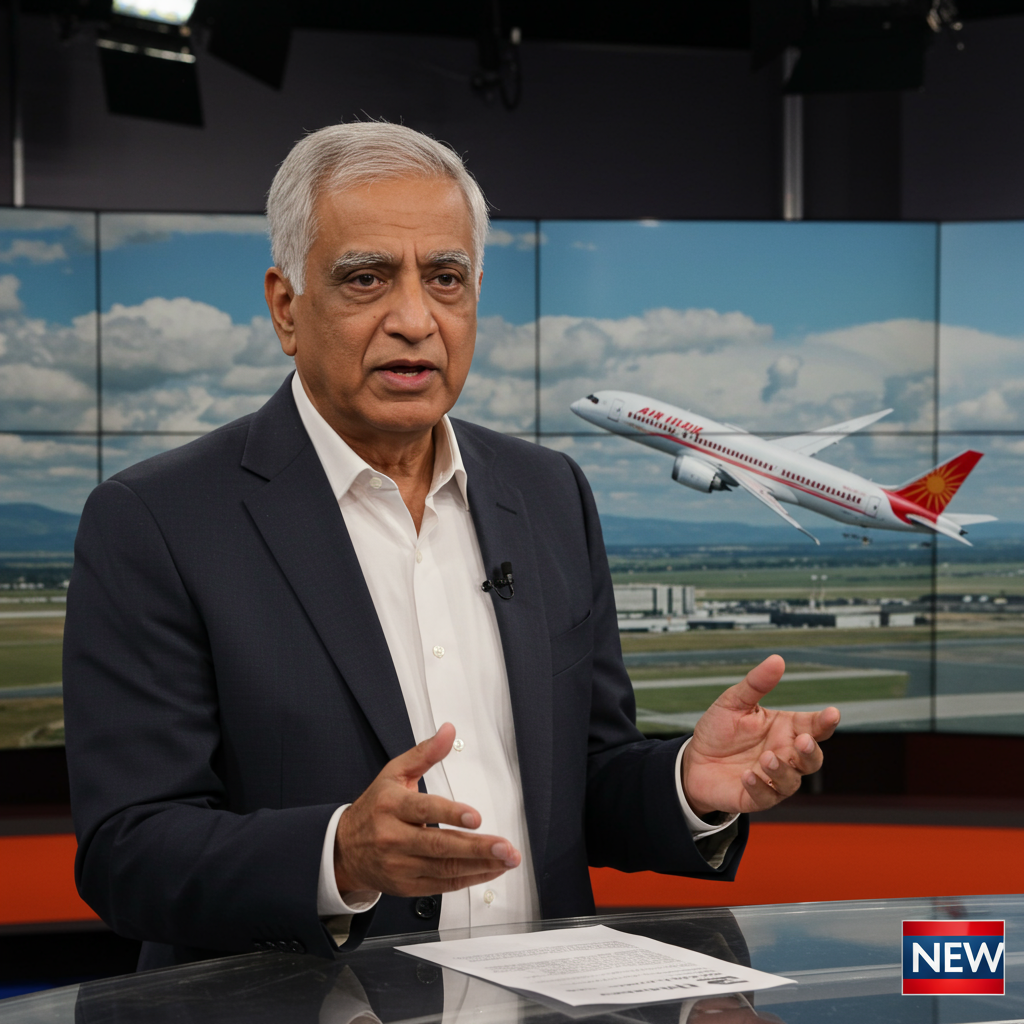A recent fatal crash involving Air India Flight 171 has drawn sharp focus from aviation experts, particularly following the release of preliminary findings. One leading figure in Indian aviation safety has advanced a startling theory: the possibility that deliberate human action, potentially even suicide, may have caused the tragedy. This perspective comes just days after investigators released initial details of the crash, which occurred moments after the Boeing 787-8 Dreamliner departed Ahmedabad on June 12.
The devastating incident resulted in significant loss of life, with 241 of the 242 individuals onboard perishing, alongside 19 fatalities on the ground, bringing the total death toll to 260 people. Only a single passenger survived the crash. The Aircraft Accident Investigation Bureau (AAIB) of India’s preliminary report highlighted a critical sequence of events that aviation safety veterans are now scrutinizing intensely.
Expert Flags Deliberate Action in Air India Crash
Captain Mohan Ranganathan, widely regarded as one of India’s foremost aviation safety experts, has openly suggested that the crash of Air India Flight 171 may have originated from intentional acts within the cockpit. His assessment centers on specific findings detailed in the AAIB’s preliminary report, including the manipulation of fuel cutoff switches and nuances within the cockpit voice recordings.
Speaking about the investigation’s initial findings, Captain Ranganathan emphasized that the evidence strongly indicates a deliberate act. He stated that turning off the fuel supply to the engines while the aircraft was climbing out after takeoff required manual intervention. This action, he asserts, could not have been accidental.
The AAIB’s Preliminary Findings
The preliminary investigation report, a critical step in understanding any aviation disaster, provided key factual details about the final moments of Air India Flight 171. The report confirmed that the Boeing 787-8 Dreamliner, en route from Ahmedabad to London Gatwick, took off from Sardar Vallabhbhai Patel International Airport. Moments after becoming airborne, both engines lost thrust.
Flight data and cockpit voice recordings reviewed by investigators reportedly show that the fuel control switches for both Engine 1 and Engine 2 were moved to the “CUTOFF” position. This occurred in rapid succession, within one second between the two switches. This action immediately starved the engines of fuel, leading to a rapid loss of power and the subsequent crash into a medical hostel located just over a mile from the runway end.
Dissecting the Fuel Cutoff Mechanism
Captain Ranganathan specifically highlighted the design of the fuel selector switches on the Boeing 787 Dreamliner. He explained that these are not easily moved inadvertently. The switches are designed with a guard rail and require a distinct pull-out action before they can be toggled to the “off” position.
“It cannot be done automatically or due to a power failure,” Captain Ranganathan explained, referencing the physical design that prevents accidental activation. “You have to pull them out to move them up or down. The possibility of inadvertently moving them to the ‘off’ position doesn’t arise. It’s definitely a case of deliberate manual selection.” Another aviation expert, former pilot Terry Tozer, echoed this sentiment, describing the act of cutting fuel seconds after takeoff as “absolutely bizarre.” He noted that while these switches are used in some emergency procedures, attempting this at low altitude would not allow enough time for engine recovery.
Pilot Roles and Cockpit Dynamics
Further supporting his hypothesis of deliberate action, Captain Ranganathan pointed to standard cockpit procedures during takeoff. The pilot flying (PF) typically has both hands on the control column during the critical phase of rotation and initial climb. The pilot monitoring (PM), however, is free to handle other tasks.
In the case of Flight 171, the AAIB report indicated that the Captain was the pilot monitoring, while the First Officer was the pilot flying. Captain Ranganathan argued that this assignment is crucial. He suggested that the pilot monitoring is the only crew member with readily available hands to manipulate switches on the central pedestal, where the fuel controls are located, during this phase of flight. This perspective adds weight to the argument that the action was intentional and performed by the Captain.
Captain Ranganathan also raised concerns about the reporting of the cockpit voice recording content in the preliminary report. The report noted one pilot asking “Why did you do it?” and the other responding “I did not do it.” Ranganathan found the use of vague terms like “one pilot” and “the other pilot” problematic. He stated that CVR analysis should clearly identify which microphone captured the audio, indicating whether it came from the Captain’s or First Officer’s station. He suggested this ambiguity in reporting could potentially obscure important details.
Concerns Over Medical History and Pilot Well-being
Delving deeper into potential motives behind a deliberate act, Captain Ranganathan stated that he had received information from serving Air India pilots regarding the Captain’s health. He claimed that one of the crew members had a known medical history and had been on extended medical leave prior to the fatal flight.
While the AAIB preliminary report confirmed that both pilots held valid medical certificates and had passed recent checks, Captain Ranganathan stressed the importance of a more comprehensive investigation. He urged investigators to look into the psychological and behavioral health of the flight crew, examining their history not just in the immediate days before the crash but over the preceding months. Such an inquiry, he suggested, could reveal underlying issues like stress or depression that might contribute to extreme actions. This call highlights a critical, often overlooked, aspect of aviation safety.
Precedents: Analyzing Other Suspected Intentional Crashes
While rare, incidents where pilots are suspected of intentionally causing a crash are not without precedent in modern aviation history. Captain Ranganathan cited several past cases to underscore this possibility.
He referenced the tragic Germanwings Flight 9525 crash in 2015, where the co-pilot deliberately crashed the aircraft into the French Alps. Other suspected incidents include EgyptAir Flight 990 in 1999, SilkAir Flight 185 in 1997, and more recently, China Eastern Airlines Flight 5735 in 2022. In the case of Malaysia Airlines Flight MH370, which disappeared in 2014, many experts continue to believe the pilot may have deliberately diverted the aircraft. Ranganathan shared his personal experience, noting he gave evidence against the Captain in the SilkAir crash investigation, which was ultimately ruled a suicide despite initial attempts by authorities to suggest mechanical failure. These historical cases demonstrate that deliberate pilot actions, while shocking, are a known risk factor in aviation safety.
Broader Issues: Regulatory Oversight and Mental Health
Beyond the specifics of Flight 171, Captain Ranganathan used the incident to highlight systemic issues within the Indian aviation sector. He criticized airlines and the Directorate General of Civil Aviation (DGCA), India’s aviation regulator, for allegedly failing to implement adequate mental health safeguards for pilots. He contended that warnings about this vulnerability have been ignored for years.
Ranganathan argued that factors like demanding flight time limitations and insufficient rest periods push pilots to their physical and mental limits. This relentless pressure can severely impact family life and lead to significant stress. He lamented that Indian airlines do not typically maintain psychiatric profiles of pilots during routine medical evaluations, a practice he believes is essential. The prioritization of connectivity and schedules, he suggested, treats pilots as machines rather than human beings, contributing to a stressful environment that can have dangerous consequences.
Official Response and Calls for Patience
Following the release of the AAIB’s preliminary report and the subsequent expert commentary, India’s Civil Aviation Minister, Kinjarapu Ram Mohan Naidu, urged caution. The Minister advised against jumping to conclusions based solely on the initial findings.
Minister Naidu praised the nation’s pilots and crew, describing them as the “backbone of civil aviation.” He affirmed the government’s commitment to their welfare and well-being. Emphasizing the technical complexities involved in the investigation, he stated that it would be premature to comment definitively on the cause of the crash until the final report is completed and released. Affected families, already grappling with profound grief, are keenly awaiting these final findings for definitive answers regarding the tragedy. Specialist aviation lawyers representing some families have described the preliminary report’s findings as “deeply concerning” and are advising families seeking justice not to rush into compensation agreements without independent legal counsel. The UK government has also indicated it will review the report closely.
Frequently Asked Questions
What specific evidence suggests the Air India crash was deliberate?
Captain Mohan Ranganathan, a leading aviation expert, points to several key pieces of evidence from the preliminary report. Primarily, he cites the flight data indicating that both engine fuel control switches were manually moved to the “CUTOFF” position within seconds of each other during takeoff. He notes that the switches are physically designed to prevent accidental movement, requiring a deliberate pull-out action. Additionally, he references cockpit voice recordings showing one pilot questioning why the fuel was cut off, which suggests awareness of the action by at least one crew member.
What are the potential factors Captain Ranganathan suggests contributed to the crash?
Beyond the immediate action of cutting fuel, Captain Ranganathan raises concerns about potential underlying factors. He claims to have heard reports from other pilots that the Captain of Flight 171 had a known medical history and had been on extended medical leave previously. He argues that the investigation should thoroughly examine the psychological and behavioral health of the pilots in the months leading up to the crash. Furthermore, he criticizes broader systemic issues within Indian aviation, including pilot fatigue due to excessive flight times and a lack of adequate mental health screening and support from airlines and regulators (DGCA).
What is the current status of the Air India Flight 171 investigation?
The investigation into the Air India Flight 171 crash is ongoing. The Aircraft Accident Investigation Bureau (AAIB) of India has released a preliminary report detailing initial factual findings, such as the fuel cutoff event. However, this report is not the final conclusion on the cause. India’s Civil Aviation Minister has stated that it is too early to determine the definitive cause and urged the public and media not to jump to conclusions until the comprehensive final report is published. Families of the victims, along with aviation experts globally, await the final findings to understand exactly what led to the tragic loss of life.
Conclusion: Waiting for the Final Report
The preliminary findings into the Air India Flight 171 crash reveal a disturbing sequence of events: the intentional cutting of fuel supply to both engines moments after takeoff. While investigators continue their work to determine the official cause, the assertion by a respected expert like Captain Mohan Ranganathan that this was a deliberate act, possibly pilot suicide, introduces a deeply unsettling dimension to the tragedy.
His analysis, rooted in the technical details of the aircraft controls and standard cockpit procedures, coupled with concerns about pilot well-being and regulatory oversight, presents a compelling, albeit grim, scenario. As the aviation community and the grieving families await the final, comprehensive report, the preliminary findings serve as a stark reminder of the complex interplay between human factors, aircraft systems, and the critical importance of robust safety protocols, including mental health support for those entrusted with thousands of lives in the sky. Only a full and transparent investigation can provide the definitive answers needed to understand this disaster and prevent similar tragedies in the future.
Word Count Check: 1150


